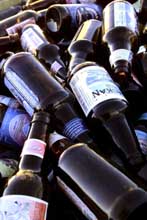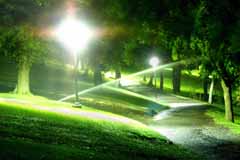USU thinks green
A Utah State University task force committee says the campus needs an environmental attitude change.
The committee, consisting of USU faculty, staff and students, released a draft of AggiEcology, a report focusing on creating a sustainable environment on campus, or “meeting present needs without compromising the ability of future generations to meet their needs.”
The goals of the report range from reducing water waste and fossil fuel dependence to promoting ecological literacy.
“USU is really serious about transforming itself into a university that cares about the environment, not only in terms of what it espouses but what it actually does,” said Terry Sharik, head of the environment and society department and member of the task force committee.
The committee suggested requiring all students to take a course in environmental issues, along with the other general education requirements of math, science and humanities. The Educational Policies Committee in the Faculty Senate would first need to approve the change.
“I think that [class] would be tremendous,” Sharik said. “That really is awareness-raising and I think that’s really important.”
Nancy Mesner, assistant professor in the aquatics, watershed and earth resources department and extension specialist in water quality, said the point of the class would not be to get students to advocate any specific political positions.
“We’re not trying to force students to join Greenpeace,” Mesner said. “We’re trying to provide students with ideas and information, to allow them to start thinking about issues in terms of how we fit into the larger environment. I think there is a distinction there.”
Committee member Craig Johnson, professor in the department of landscape architecture and environmental planning, said an important goal is to use more canal water in place of the culinary (drinkable) water that is still used on some of the lawns at Housing and in other campus areas. The report also says most dorms lack low-flow faucet and shower devices. The university has already made progress in recent years, Johnson said, but it isn’t enough.
“There are a lot of good things going on in terms of water-sprinkler design,” Johnson said. “But there are other things that need to be added on to what’s already being done.”
President Kermit L. Hall, who would need to approve the report before it becomes policy, agreed.
“The most important message is, USU has done a good job of addressing environmental issues, but the report makes clear that in comparison with other institutions around the country we can probably do more,” Hall said.
One concern, according to the report, is that the University Paint Shop is disposing of paint-contaminated wastewater into the sewer system, adding toxic chemicals to the university’s wastewater.
Improvements to campus transportation are suggested in the report, such as a plan to reduce car use by 25 percent over the next 10 years through “a package of incentives (and disincentives) that discourages members of the Utah State community from bringing cars to campus,” and the addition of a 7:45 to 8:15 a.m. campus express route to alleviate congestion.
The committee hopes to convert at least a fifth of the campus grounds to drought-tolerant native vegetation and increase the overall waste-recycling rate from the current 24 percent to 50 percent over a five-year period. It also recommended the university give a discount on beverage sales to those who bring their own mug or glass.
“It’s really about changing behavior, in terms of faculty, students and staff,” Johnson said. “That may require us to suggest changes in policies and other things that will facilitate energy conservation and reduced water use.”
Sharik said a number of factors contributed to the formation of the task force committee. In 1991, former USU President Stanford Cazier and president-elect George Emert signed the Talloires Declaration, a document pledging to work toward an environmentally sustainable future.
According to the report, “Since then, Utah State has made only what could be termed as sluggish progress of implementing in theory or practice the tenets of the Talloires Declaration.”
Hall said he sent copies of the draft to the deans, the Associated Students of USU and others to gather input from their constituents over the next six weeks. He said he would collect their comments and hopefully give a coherent view of the university’s direction in his State of the University address in several months.
“I think the report is a step in the right direction, but what is important at this stage is for various constituencies around campus to react to it,” Hall said.
Sharik said he was confident the university will eventually adopt the report’s guidelines for environmental sustainability.
“I think within the first year, we’ll be getting to see some really significant changes,” Sharik said. “I think people are poised to do it.”
The committee separated its suggestions into short-term, mid-term, and long-term goals.
“None of these things are going to happen overnight, [but] a lot of time and effort went into it,” Johnson said. “One would hope that kind of time and energy and dollar value would get some kind of response.”
Mesner said the renewed focus on sustainability would help USU become a better environmental citizen.
“I’m pretty excited about the opportunity of the university to be a little bit more proactive in this area. If we want to be good role models in the community, this is a good opportunity,” Mesner said.
Johnson said, “It seems to me there is a genuine concern to try and move forward. It’s a real opportunity for this institution to make a statement, so you don’t just hear us talking about [sustaining the environment], you can come up and see us doing it.”
Johnson said the report is as significant as people want to make it.
“I think [the report] is well-done and deals with the issues that need to be addressed,” he said.
Sharik said, “I think it’s exciting that we’re moving in this direction, and I look forward to seeing considerable progress.”
To view the report in its entirety, visit www.usu.edu/about/president/pdfs/AggiEcology2.pdf.
– heidithue@cc.usu.edu

Glass beer bottles await recycling at the USU Recycling Center.

Sprinklers water Old Main hill early Tuesday morning. The task force committee is recommending USU improve its efforts to use canal water on all university areas, rather than culinary water, to irrigate lawns. (Photos by Aaron Hogan)

